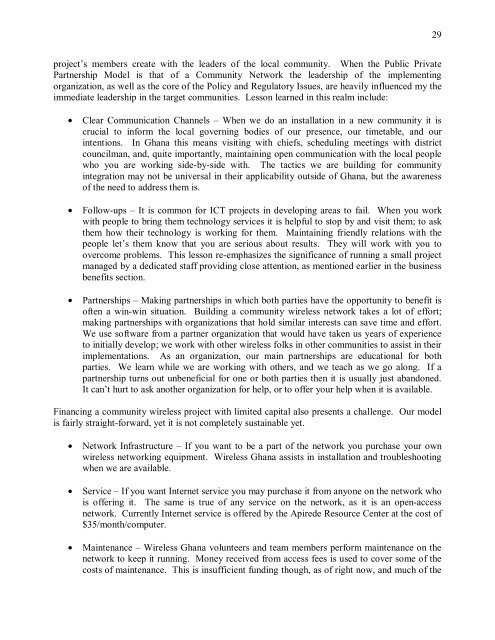Wireless Ghana: A Case Study
Wireless Ghana: A Case Study
Wireless Ghana: A Case Study
You also want an ePaper? Increase the reach of your titles
YUMPU automatically turns print PDFs into web optimized ePapers that Google loves.
29<br />
project’s members create with the leaders of the local community. When the Public Private<br />
Partnership Model is that of a Community Network the leadership of the implementing<br />
organization, as well as the core of the Policy and Regulatory Issues, are heavily influenced my the<br />
immediate leadership in the target communities. Lesson learned in this realm include:<br />
• Clear Communication Channels – When we do an installation in a new community it is<br />
crucial to inform the local governing bodies of our presence, our timetable, and our<br />
intentions. In <strong>Ghana</strong> this means visiting with chiefs, scheduling meetings with district<br />
councilman, and, quite importantly, maintaining open communication with the local people<br />
who you are working side-by-side with. The tactics we are building for community<br />
integration may not be universal in their applicability outside of <strong>Ghana</strong>, but the awareness<br />
of the need to address them is.<br />
• Follow-ups – It is common for ICT projects in developing areas to fail. When you work<br />
with people to bring them technology services it is helpful to stop by and visit them; to ask<br />
them how their technology is working for them. Maintaining friendly relations with the<br />
people let’s them know that you are serious about results. They will work with you to<br />
overcome problems. This lesson re-emphasizes the significance of running a small project<br />
managed by a dedicated staff providing close attention, as mentioned earlier in the business<br />
benefits section.<br />
• Partnerships – Making partnerships in which both parties have the opportunity to benefit is<br />
often a win-win situation. Building a community wireless network takes a lot of effort;<br />
making partnerships with organizations that hold similar interests can save time and effort.<br />
We use software from a partner organization that would have taken us years of experience<br />
to initially develop; we work with other wireless folks in other communities to assist in their<br />
implementations. As an organization, our main partnerships are educational for both<br />
parties. We learn while we are working with others, and we teach as we go along. If a<br />
partnership turns out unbeneficial for one or both parties then it is usually just abandoned.<br />
It can’t hurt to ask another organization for help, or to offer your help when it is available.<br />
Financing a community wireless project with limited capital also presents a challenge. Our model<br />
is fairly straight-forward, yet it is not completely sustainable yet.<br />
• Network Infrastructure – If you want to be a part of the network you purchase your own<br />
wireless networking equipment. <strong>Wireless</strong> <strong>Ghana</strong> assists in installation and troubleshooting<br />
when we are available.<br />
• Service – If you want Internet service you may purchase it from anyone on the network who<br />
is offering it. The same is true of any service on the network, as it is an open-access<br />
network. Currently Internet service is offered by the Apirede Resource Center at the cost of<br />
$35/month/computer.<br />
• Maintenance – <strong>Wireless</strong> <strong>Ghana</strong> volunteers and team members perform maintenance on the<br />
network to keep it running. Money received from access fees is used to cover some of the<br />
costs of maintenance. This is insufficient funding though, as of right now, and much of the


